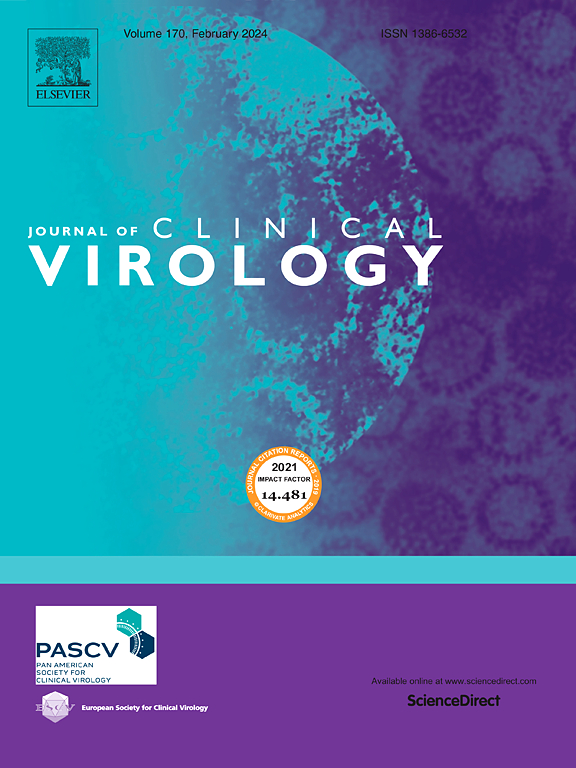Serological analysis of COVID-19 patients highlights cross-reactivity of antibodies with the HIV-1 2F5 epitope
IF 3.4
3区 医学
Q2 VIROLOGY
引用次数: 0
Abstract
The Coronavirus disease 2019 (COVID-19) pandemic has raised concerns regarding the specificity of serological assays due to potential antibody cross-reactivity. In this study, we analyzed sera from 57 individuals infected with the severe acute respiratory syndrome coronavirus 2 (SARS-CoV-2) using enzyme-linked immunosorbent assay (ELISA) to assess antibody recognition of a human immunodeficiency virus type 1 (HIV-1) envelope epitope (2F5). Cross-reactive binding to the HIV-1 antigen was detected in 38.5 % (22/57) of samples, indicating nonspecific antibody recognition. Interestingly, sera from HIV-1-infected individuals and the monoclonal anti-2F5 antibody exhibited no reactivity toward the SARS-CoV-2 Spike receptor-binding domain (RBD), indicating that cross-reactivity occurs in a unidirectional manner and does not compromise the specificity of RBD-based diagnostic assays. These findings support the specificity of RBD-targeted assays and advocate for careful interpretation of HIV-1 serological assays in individuals with recent SARS-CoV-2 infection, particularly where dual circulation occurs.
COVID-19患者的血清学分析强调了与hiv - 12f5表位的抗体的交叉反应性
由于潜在的抗体交叉反应性,2019冠状病毒病(COVID-19)大流行引起了对血清学检测特异性的担忧。在这项研究中,我们使用酶联免疫吸附试验(ELISA)分析了57例严重急性呼吸综合征冠状病毒2 (SARS-CoV-2)感染者的血清,以评估抗体对人类免疫缺陷病毒1型(HIV-1)包膜表位(2F5)的识别。在38.5% %(22/57)的样本中检测到与HIV-1抗原的交叉反应结合,表明非特异性抗体识别。有趣的是,来自hiv -1感染者的血清和单克隆抗2f5抗体对SARS-CoV-2刺突受体结合域(Spike receptor-binding domain, RBD)没有反应性,表明交叉反应以单向方式发生,不会损害基于RBD的诊断检测的特异性。这些发现支持rbd靶向检测的特异性,并主张对近期SARS-CoV-2感染个体的HIV-1血清学检测进行仔细解释,特别是在发生双循环的情况下。
本文章由计算机程序翻译,如有差异,请以英文原文为准。
求助全文
约1分钟内获得全文
求助全文
来源期刊

Journal of Clinical Virology
医学-病毒学
CiteScore
22.70
自引率
1.10%
发文量
149
审稿时长
24 days
期刊介绍:
The Journal of Clinical Virology, an esteemed international publication, serves as the official journal for both the Pan American Society for Clinical Virology and The European Society for Clinical Virology. Dedicated to advancing the understanding of human virology in clinical settings, the Journal of Clinical Virology focuses on disseminating research papers and reviews pertaining to the clinical aspects of virology. Its scope encompasses articles discussing diagnostic methodologies and virus-induced clinical conditions, with an emphasis on practicality and relevance to clinical practice.
The journal publishes on topics that include:
• new diagnostic technologies
• nucleic acid amplification and serologic testing
• targeted and metagenomic next-generation sequencing
• emerging pandemic viral threats
• respiratory viruses
• transplant viruses
• chronic viral infections
• cancer-associated viruses
• gastrointestinal viruses
• central nervous system viruses
• one health (excludes animal health)
 求助内容:
求助内容: 应助结果提醒方式:
应助结果提醒方式:


